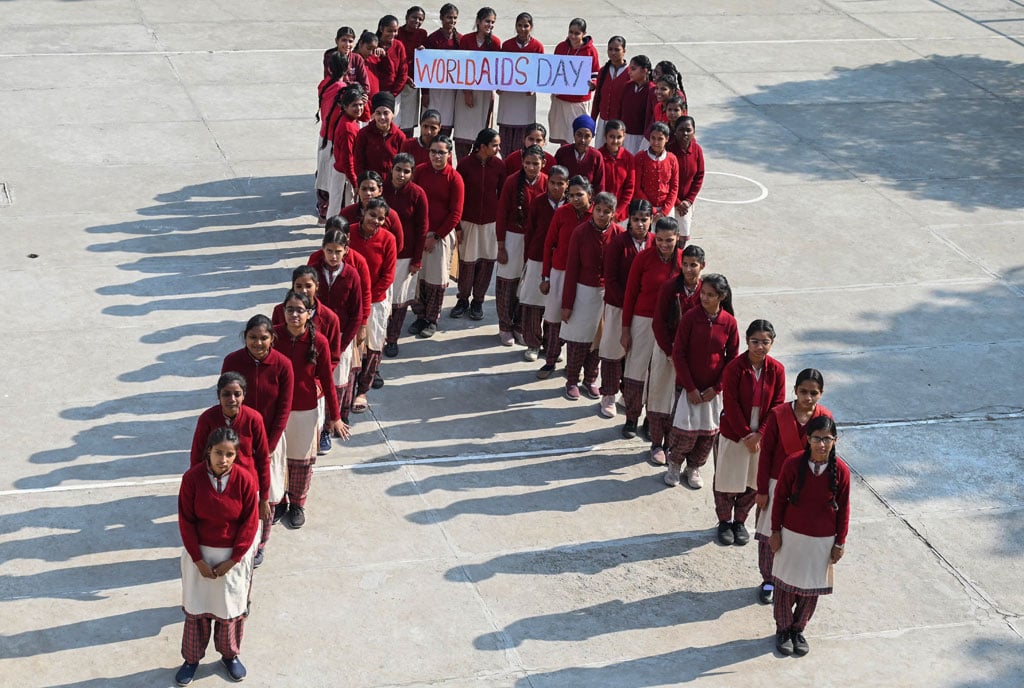Prime
Don’t put brakes on HIV/Aids fight

School students pose for a photograph as they stand in the shape of a ribbon as part of an awareness event on the eve of the 'World AIDS Day' at a Government Girls’ senior secondary school in Amritsar on November 30, 2022. PHOTO/AFP
What you need to know:
- The issue: HIV/Aids fight
- Our view: We back the Uganda AIDS Commission’s call on the government to raise funds for the war on HIV/Aids by contributing at least half of the budget.
Uganda will join the rest of the globe in commemorating World Aids Day today, but in order to maintain the hard-won victories, the nation must step up its efforts to combat HIV/Aids. Every week, about 1,000 people become HIV-positive, and 325 people pass away from Aids-related causes in the country.
That works out to 46 people daily from known cases. For instance, there are worries that the Lango region is losing the battle against the fatal disease as the number of new HIV/Aids infections keeps rising. It is not an isolated case.
On World Aids Day, we remember the more than 40 million people who have died from Aids, assess the Aids response, and pledge to put an end to Aids. Uganda ought to support initiatives designed to prevent an increase in the number of people living with HIV/Aids. The United Nation’s analysis conducted ahead of the World Aids Day shows that inequality is impeding efforts to eradicate Aids. On the current trajectory, the world will not reach the Aids-related global targets.
The Aids response is in danger, according to UNAIDS, as new infections are increasing and deaths are still occurring in many parts of the world. Inequalities are the root cause, according to a recent UNAIDS analysis. It demonstrates how global leaders might address these disparities and exhorts them to have courage and heed what the facts indicate.
According to government statistics, infections among young people are on the rise (15-24 years). In 2021, they were responsible for 37 percent of all new HIV infections, with young girls three times more likely to contract the virus than males during that time. Teenage girls and young women (15–24 years old) in sub-Saharan Africa are three times more likely than adolescent boys and young men in the same age range to get HIV. The remaining 32 percent of the 88,000 children with HIV/Aids who are known to exist are at risk of dying early since only 68 percent of them are on antiretroviral (ARV) therapy.
Multiple sexual partnerships, sexual and gender-based violence, child marriages, transactional sex, income inequality, poverty, high rates of school dropout, stigma and discrimination, and unequal access to prevention, care, and treatment services are just a few of the factors that need to be addressed in order to stop the spread of new infections.
The fight against HIV/Aids in Uganda contains both bright spots and areas for improvement. While we recognise the donors’ contribution to the battle against the disease, we must also be aware that they will eventually stop giving. We back the Uganda AIDS Commission’s call on the government to raise funds for the war on HIV/Aids by contributing at least half of the budget.
Only 12 per cent of HIV/Aids programmes are now funded by the government, leaving the remaining 80 percent to donors and the business sector. Political interventions are necessary, which have traditionally been crucial in solving the issue. We call for the mobilisation of government resources, religious authority, and non-state organisations in this fight.




